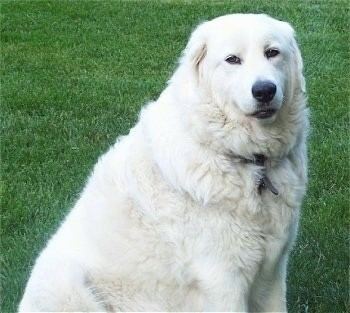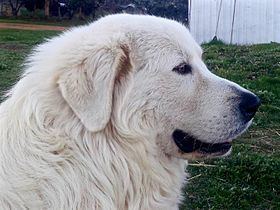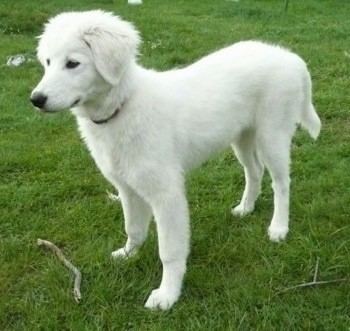Group 5 (Working Dogs) standard Scientific name Canis lupus familiaris Weight Male: 35–45 kg | ANKC Group 5 (Working Dogs) KC (UK) Pastoral Height Male: 65–73 cm | |
 | ||
Other names Cane da Pastore Maremmano-AbruzzesePastore AbruzzesePastore MaremmanoAbruzzo SheepdogAbruzzese Sheepdog FCI Group 1, Section 1 Sheepdogs #201 Temperament Alert, Loyal, Friendly, Determined, Dignified, Intelligent Colors Black, White, Grey, Cream, Brown Similar Bergamasco Shepherd, Komondor, Slovak Cuvac, Akbash dog, Kuvasz | ||
Maremma dogs guard goats near terrebonne
The Maremma-Abruzzese Sheepdog, Maremma Sheepdog, or Abruzzo Sheepdog, in Italian referred to as Cane da pastore Maremmano-Abruzzese, Pastore Abruzzese, or Pastore Maremmano; and often referred to as just Maremmano outside of Italy, is a breed of livestock guardian dog indigenous to central Italy, particularly to Abruzzo and the Maremma region of Tuscany and Lazio. It has been used for centuries by Italian shepherds to guard sheep from wolves. The rough English translation of the official Italian name, "cane da pastore Maremmano-Abruzzese", is "dog of the shepherds of the Maremma and Abruzzese region". The English name of the breed derives from that of the Maremma marshlands, where until recently shepherds, dogs and hundreds of thousands of sheep over-wintered, and where the breed is today abundant although sheep-farming has decreased substantially. The breed is widely employed in Abruzzo, where sheep herding remains vital to the rural economy and the wolf remains an active and protected predator. Shepherds in Abruzzo also use the closely related and similar-looking Abruzzese Mastiff to guard sheep. Other similar breeds include the Pyrenean Mountain Dog, the Kuvasz of Hungary, the Tatra of Poland, the Cuvac of Slovakia and the Šarplaninac (although not white), with all of which it may share a common ancestor; and the Akbash Dog of Turkey. See Mountain dog breeds.
Contents
- Maremma dogs guard goats near terrebonne
- Maremma sheepdog
- Appearance
- Ancient history and iconography
- Recent history
- Use
- Training
- References

Maremma sheepdog
Appearance

The Maremma Sheepdog has a solid, muscular build, a thick white coat, a large head and a black nose. According to the breed standard, males should weigh 35 to 45 kilograms (77 to 99 lb) and stand 65 to 73 centimetres (26 to 29 in) at the shoulder, while females weigh 30 to 40 kilograms (66 to 88 lb) and stand 60 to 68 centimetres (24 to 27 in). Some dogs may be considerably larger. The coat is long and thick; it is rough to the touch, and forms a thick collar around the neck. It should be solid white; some minor yellowing may be tolerated.

Some divide the breed into various subtypes, largely based on small differences in physical attributes and with subtype names based on village and provincial names where the dogs may be found, e.g. the Maremmano, the Marsicano, the Aquilano, the Pescocostanzo, the Maiella, and the Peligno. However, biologists dispute this division, as well as over reliance on minor physical differences, as the dogs were bred over the centuries for their behavioral characteristics as flock guardians.
Ancient history and iconography
Descriptions of white sheep defense dogs are found in ancient Roman literature, in works such as those of Columella, Varro and Palladius. Similar dogs are depicted in numerous sculptures and paintings from Roman times to the present. Among the earliest is the series of large statues (two in Rome, one in Florence, one – the Duncombe Dog – in England) copied from a Hellenistic bronze from Pergamon. Iconographic sources that have been identified as relevant to the history of the Maremmano include:
Recent history
The first registration of the Maremmano in the Libro delle Origini Italiano of the Kennel Club Italiano, as it was then called, was of four dogs in 1898. There were no further registrations for many years. In 1940 there were 17 dogs registered. The first standard for the breed was drawn up in 1924 by Luigi Groppi and Giuseppe Solaro.
Until 1958 the Pastore Maremmano, or shepherd dog of the Maremma, and the Pastore Abruzzese, or shepherd dog of the Abruzzi, were regarded as separate breeds. A breeder's society for the Pastore Abruzzese was formed in 1950, and one for the Maremmano in 1953. On 1 January 1958 the breeds were unified by the ENCI, the Ente Nazionale della Cinofilia Italiano, the national dog association of Italy. The explanation given is that a "natural fusion" of the two types had occurred as a result of movement of the dogs due to transhumance of sheep flocks from one region to another, particularly after the unification of Italy. Until 1860, the mountains of the Abruzzo and the plains of the Maremma lay in different countries.
As sheep farming developed into an annual trek or transhumance from mountain grasslands of Abruzzo and Molise (and other parts of central Italy) south to lower pasture land in Puglia where sheep were over-wintered, the dogs came to play a central role in the centuries-old migration, an annual event vital to Abruzzese culture. Maremmano dogs continue to be widely used by Italian sheep farmers in areas where predation is common, such as the Apennines of central Italy and the open range land of national parks in Abruzzo. Besides their wide use in Italy, Maremma Sheepdogs are extensively used as Livestock guardian dogs in Australia, Canada and the United States.
Use
The traditional use of the Maremmano dog is as a guardian for the protection of sheep flocks against wolves. Columella, writing in the first century AD, recommends white dogs for this purpose, as the shepherd can easily distinguish them from the wolf, while Varro suggests that white dogs have a "lion-like aspect" in the dark. The dogs work in groups; three or four dogs are an adequate defense against wolves and stray dogs. Their function is mostly one of dissuasion, actual physical combat with the predator being relatively rare. Nevertheless, working dogs may be fitted with a roccale (or vreccale), a spiked iron collar which protects the neck in combat. The ears of working dogs are normally cropped.
Training
Maremma used as livestock guardian dogs are introduced to sheep flocks as puppies so they bond to the sheep. Some ranchers place Maremma puppies as young as 3–4 weeks old with young lambs though beginning this bonding process at 7–8 weeks is more typical. Although it is easiest to bond Maremma to sheep and goats, cattle ranchers have found that the dogs bond with cows and Maremma are increasingly used to protect range cattle. Some ranchers have successfully trained Maremmas to protect free-range fowl, such as chickens, from predation from both ground threats such as coyotes, stray dogs and foxes as well as aerial threats such as raptors (hawks, eagles, owls, etc.).
In Warrnambool, Australia, the world's first trial using a Maremma to guard a dwindling little penguin population on Middle Island against fox attack, commenced in 2006. This project won the 2010 Australian Government Coastcare Award. There is a Wombat Rescue organization in New South Wales, Australia that uses one to help tend and protect rescued wombats. While using Maremma to guard an endangered species is rare, Maremma along with other breeds of livestock guarding dogs are appreciated by environmentalists because they make it possible for livestock to coexist with predators such as wolves and coyotes, reducing their predation by 70% to 80% or more. National park authorities in Canada, Italy and the United States have promoted use of the Maremma Sheepdog as well as other types of livestock guarding dogs to minimize conflict between endangered predator species and ranchers.
